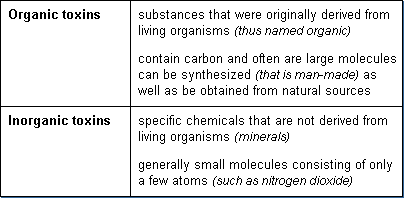|
 |
 |
 |
 |
|
|
|






Basic Toxicology Terminology

Toxicology is an evolving medical science and so is toxicology terminology. Most terms are quite specific and will be defined as they appear in the tutorial. However, some terms are more general and used throughout the various sections. Those most commonly used are discussed in the following frames.
Toxicology is the study of the adverse effects of chemicals or physical agents on living organisms. A toxicologist is a scientist that determines the harmful effects of agents and the cellular, biochemical, and molecular mechanisms responsible for the effects.
Terminology and definitions for materials that cause toxic effects are not always consistently used in the literature. The most common terms are toxicant, toxin, poison, toxic agent, toxic substance, and toxic chemical.
Toxicant, toxin, and poison are often used interchangeably in the literature; however, there are subtle differences as indicated below:

A toxic agent is anything that can produce an adverse biological effect. It may be chemical, physical, or biological in form. For example, toxic agents may be chemical (such as cyanide), physical (such as radiation) and biological (such as snake venom).
A distinction is made for diseases due to biological organisms. Those organisms that invade and multiply within the organism and produce their effects by biological activity are not classified as toxic agents. An example of this is a virus that damages cell membranes resulting in cell death.
If the invading organisms excrete chemicals which is the basis for toxicity, the excreted substances are known as biological toxins. The organisms in this case are referred to as toxic organisms. An example is tetanus. Tetanus is caused by a bacterium, Clostridium tetani. The bacteria C. tetani itself does not cause disease by invading and destroying cells. Rather, it is a toxin that is excreted by the bacteria that travels to the nervous system (a neurotoxin) that produces the disease.
A toxic substance is simply a material which has toxic properties. It may be a discrete toxic chemical or a mixture of toxic chemicals. For example, lead chromate, asbestos, and gasoline are all toxic substances. Lead chromate is a discrete toxic chemical. Asbestos is a toxic material that does not consist of an exact chemical composition but a variety of fibers and minerals. Gasoline is also a toxic substance rather than a toxic chemical in that it contains a mixture of many chemicals. Toxic substances may not always have a constant composition. For example, the composition of gasoline varies with octane level, manufacturer, time of season, etc.
Toxic substances may be organic or inorganic in composition

Toxic substances may be systemic toxins or organ toxins.
A systemic toxin is one that affects the entire body or many organs rather than a specific site. For example, potassium cyanide is a systemic toxicant in that it affects virtually every cell and organ in the body by interfering with the cell's ability to utilize oxygen.
Toxicants may also affect only specific tissues or organs while not producing damage to the body as a whole. These specific sites are known as the target organs or target tissues.
 |
 |
 |
|  | Benzene is a specific organ toxin in that it is primarily toxic to the blood-forming tissues.
|
 |
|  | Lead is also a specific organ toxin; however, it has three target organs (central nervous system, kidney, and hematopoietic system).
|
 |
A toxicant may affect a specific type of tissue (such as connective tissue) that is present in several organs. The toxic site is then referred to as the target tissue.
There are many types of cells in the body and they can be classified in several ways.
 |
 |
 |
|  | basic structure (e.g., cuboidal cells)
|
 |
|  | tissue type (e.g., hepatocytes of the liver)
|
 |
|  | germinal cells (e.g., ova and sperm)
|
 |
|  | somatic cells (e.g., non-reproductive cells of the body)
|
 |
Germ cells are those cells that are involved in the reproductive process and can give rise to a new organism. They have only a single set of chromosomes peculiar to a specific sex. Male germ cells give rise to sperm and female germ cells develop into ova. Toxicity to germ cells can cause effects on the developing fetus (such as birth defects, abortions).
Somatic cells are all body cells except the reproductive germ cells. They have two sets (or pairs) of chromosomes. Toxicity to somatic cells causes a variety of toxic effects to the exposed individual (such as dermatitis, death, and cancer).

  
|
|
|
|


